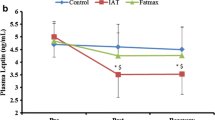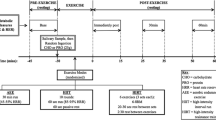Abstract
Background: Current literature shows conflicting results regarding the possible direct role of exercise on leptin concentrations, mainly because of a non-homogeneous level of energy expenditure (EE) and the lack of standardization of energy balance. Aim: The aim of the study was to evaluate the effect of exercise duration and its corresponding EE on leptin levels, during prolonged treadmill exercise, in a well-controlled laboratory setting. Materials and methods: Seven young trained males underwent a 4-h treadmill exercise. The starting intensity was set at 65% of maximal oxygen consumption. At the start of the test and throughout the exercise, venous blood samples were drawn for the assays of leptin, glucose, free fatty acids (FFA), cortisol, epinephrine (E) and norepinephrine (NE). Hourly and total EE was monitored with gas analysis. Results: Plasma leptin levels decreased from 1.10±0.15 to 0.85±0.26 µg/l (p<0.01) at the end of the exercise, reaching a significant reduction already after the second hour. FFA and cortisol showed a progressive significant increase, while glucose did not significantly change throughout the test. Plasma E and NE significantly increased at all sampling times compared to basal values (48.1±30.3 to 352.3±187.7 pg/ml, p<0.001 and 238.1±118.9 to 1798.7±413.5 pg/ml, p<0.001). The random-effects model for panel data analysis showed negative correlation between leptin, NE and the values of progressive EE (r2=0.745, p<0.05). Conclusions: Our data demonstrate that, during a prolonged moderate intensity exercise, leptin decrease is significantly related to the total EE. Further, NE concentrations seem to play an important role in the inhibition of leptin secretion.
Similar content being viewed by others
References
Bouassida A, Chamari K, Zaouali M, Feki Y, Zbidi A, Tabka Z. Review on leptin and adiponectin responses and adaptations to acute and chronic exercise. Br J Sports Med 2010, 44: 620–30.
Fisher JS, Van Pelt RE, Zinder O, Landt M, Kohrt WM. Acute exercise effect on postabsorptive serum leptin. J Appl Physiol 2001, 91: 680–6.
Legakis IN, Mantzouridis T, Saramantis A, Lakka-Papadodima E. Rapid decrease of leptin in middle-aged sedentary individuals after 20 minutes of vigorous exercise with early recovery after the termination of the test. J Endocrinol Invest 2004, 27: 117–20.
Racette SB, Coppack SW, Landt M, Klein S. Leptin production during moderate-intensity aerobic exercise. J Clin Endocrinol Metab 1997, 82: 2275–7.
Weltman A, Pritzlaff CJ, Wideman L, et al. Intensity of acute exercise does not affect serum leptin concentrations in young men. Med Sci Sports Exerc 2000, 32: 1556–61.
Olive JL, Miller GD. Differential effects of maximal- and moderate-intensity runs on plasma leptin in healthy trained subjects. Nutrition 2001, 17: 365–9.
Jurimae J, Jurimae T. Leptin responses to short term exercise in college level male rowers. Br J Sports Med 2005, 39: 6–9.
Hickey MS, Calsbeek DJ. Plasma leptin and exercise: recent findings. Sports Med 2001, 31: 583–9.
Kraemer RR, Chu H, Castracane VD. Leptin and exercise. Exp Biol Med (Maywood) 2002, 227: 701–8.
Zaccaria M, Ermolao A, Roi GS, Englaro P, Tegon G, Varnier M. Leptin reduction after endurance races differing in duration and energy expenditure. Eur J Appl Physiol 2002, 87: 108–11.
Hickey MS, Considine RV, Israel RG, et al. Leptin is related to body fat content in male distance runners. Am J Physiol 1996, 271: E938–40.
Landt M, Lawson GM, Helgeson JM, et al. Prolonged exercise decreases serum leptin concentrations. Metabolism 1997, 46: 1109–12.
Leal-Cerro A, Garcia-Luna PP, Astorga R, et al. Serum leptin levels in male marathon athletes before and after the marathon run. J Clin Endocrinol Metab 1998, 83: 2376–9.
Essig DA, Alderson NL, Ferguson MA, Bartoli WP, Durstine JL. Delayed effects of exercise on the plasma leptin concentration. Metabolism 2000, 49: 395–9.
Duclos M, Corcuff JB, Ruffie A, Roger P, Manier G. Rapid leptin decrease in immediate post-exercise recovery. Clin Endocrinol (Oxf) 1999, 50: 337–42.
Boden G, Chen X, Mozzoli M, Ryan I. Effect of fasting on serum leptin in normal human subjects. J Clin Endocrinol Metab 1996, 81: 3419–23.
Fritsche A, Wahl HG, Metzinger E, et al. Evidence for inhibition of leptin secretion by catecholamines in man. Exp Clin Endocrinol Diabetes 1998, 106: 415–8.
Scriba D, Aprath-Husmann I, Blum WF, Hauner H. Catecholamines suppress leptin release from in vitro differentiated subcutaneous human adipocytes in primary culture via beta1- and beta2-adrenergic receptors. Eur J Endocrinol 2000, 143: 439–45.
Sun SS, Chumlea WC, Heymsfield SB, et al. Development of bio-electrical impedance analysis prediction equations for body composition with the use of a multicomponent model for use in epidemiologic surveys. Am J Clin Nutr 2003, 77: 331–40.
Zaccaria M, Borea PA, Opocher G, et al. Effects of high-altitude chronic hypoxia on platelet alpha 2-receptors in man. Eur J Clin Invest 1997, 27: 316–21.
Kalsbeek A, Fliers E, Romijn JA, et al. The suprachiasmatic nucleus generates the diurnal changes in plasma leptin levels. Endocrinology 2001, 142: 2677–85.
Kanabrocki EL, Hermida RC, Wright M, et al. Circadian variation of serum leptin in healthy and diabetic men. Chronobiol Int 2001, 18: 273–83.
Radic R, Nikolic V, Karner I, et al. Circadian rhythm of blood leptin level in obese and non-obese people. Coll Antropol 2003, 27: 555–61.
Stutz AM, Staszkiewicz J, Ptitsyn A, Argyropoulos G. Circadian expression of genes regulating food intake. Obesity (Silver Spring) 2007, 15: 607–15.
Wolthers OD, Heuck C, Skjaerbaek C. Diurnal rhythm in serum leptin. J Pediatr Endocrinol Metab 1999, 12: 863–6.
Desgorces FD, Chennaoui M, Gomez-Merino D, Drogou C, Guezennec CY. Leptin response to acute prolonged exercise after training in rowers. Eur J Appl Physiol 2004, 91: 677–81.
Elias AN, Pandian MR, Wang L, Suarez E, James N, Wilson AF. Leptin and IGF-I levels in unconditioned male volunteers after short-term exercise. Psychoneuroendocrinology 2000, 25: 453–61.
Hilton LK, Loucks AB. Low energy availability, not exercise stress, suppresses the diurnal rhythm of leptin in healthy young women. Am J Physiol Endocrinol Metab 2000, 278: E43–9.
van Aggel-Leijssen DP, van Baak MA, Tenenbaum R, Campfield LA, Saris WH. Regulation of average 24h human plasma leptin level; the influence of exercise and physiological changes in energy balance. Int J Obes Relat Metab Disord 1999, 23: 151–8.
Rentsch J, Chiesi M. Regulation of ob gene mRNA levels in cultured adipocytes. FEBS Lett 1996, 379: 55–9.
Author information
Authors and Affiliations
Corresponding author
Rights and permissions
About this article
Cite this article
Zaccaria, M., Ermolao, A., Brugin, E. et al. Plasma leptin and energy expenditure during prolonged, moderate intensity, treadmill exercise. J Endocrinol Invest 36, 396–401 (2013). https://doi.org/10.3275/8656
Accepted:
Published:
Issue Date:
DOI: https://doi.org/10.3275/8656




